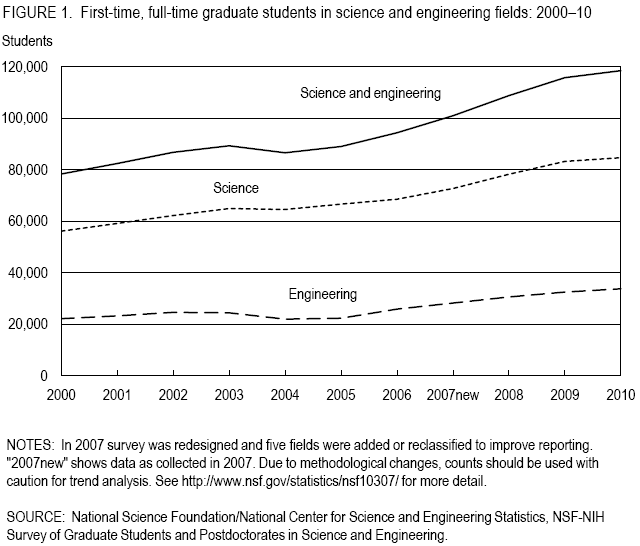|
News & Views item - June 2012 |
![]() US National Science Foundation Reports on STEM Graduate Enrolments Over Past
Decade. (June 3, 2012)
US National Science Foundation Reports on STEM Graduate Enrolments Over Past
Decade. (June 3, 2012)
An
InfoBrief dated May 2012![]() by the US National Science Foundation's (NSF) National Center for Science and
Engineering Statistics emphasises that despite what is perceived as common
knowledge in the United States that the tertiary education system isn't
supplying the numbers of qualified graduates needed to keep its economy
competitive as a result of declining student interest in the STEM fields, its
analysis found that enrolment by first-time, full-time graduate enrolment in
STEM programs rose 50% through the decade (see graph below).
by the US National Science Foundation's (NSF) National Center for Science and
Engineering Statistics emphasises that despite what is perceived as common
knowledge in the United States that the tertiary education system isn't
supplying the numbers of qualified graduates needed to keep its economy
competitive as a result of declining student interest in the STEM fields, its
analysis found that enrolment by first-time, full-time graduate enrolment in
STEM programs rose 50% through the decade (see graph below).

Furthermore, Science's Jeffrey Mervis reports that the NSF's annual Survey of Graduate Students and Postdoctorates in Science and Engineering, shows that "although foreign students make up 30% of the total enrolment in U.S. graduate science and engineering programs, and while they constitute a majority in several fields, their slice of the overall pie has not grown in the past decade. Rather, the pools of U.S. citizens and those with temporary visas each grew by 35%."
Detailed tabulation of the data is provided in the NSF report.
In addition the NSF report notes that the number of of women graduate students in STEM fields rose 40% compared to the 30% growth rate for men thereby reducing the gender discrepancy. Similarly Hispanic and African-American STEM graduate students rose by 65% and 50%, respectively, compared to the 35% growth for the overall population. However, it must be remembered they start from a relatively low base.
To date the information emanating from the Office of Australia's Chief Scientist (Ian Chubb) does not suggest a comparable increase of STEM graduates in Australia's tertiary sector, and of course whether or not the Australian economy is geared to absorb a marked growth in STEM educated graduates is another matter of conjecture.